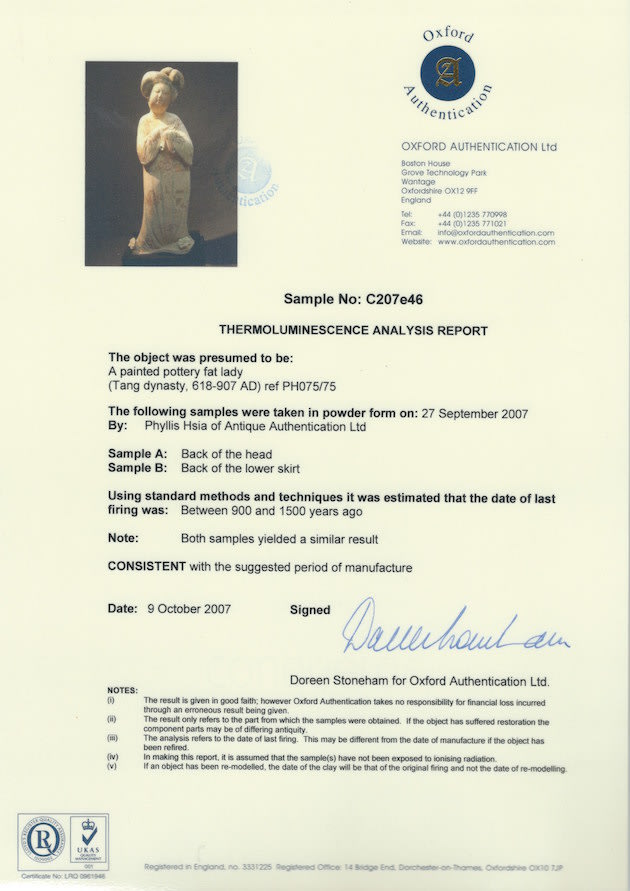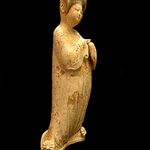Tang Sculpture of a Fat Lady, 618 CE - 907 CE
Terracotta
height 48.3 cm
height 19 in
height 19 in
DK.112 (LSO)
Further images
This beautifully-finished ceramic attendant was made during what many consider to be China’s Golden Age, the Tang Dynasty. It was at this point that China’s outstanding technological and aesthetic achievements...
This beautifully-finished ceramic attendant was made during what many consider to be China’s Golden Age, the Tang Dynasty. It was at this point that China’s outstanding technological and aesthetic achievements opened to external influences, resulting in the introduction of numerous new forms of self-expression, coupled with internal innovation and considerable social freedom. The Tang dynasty also saw the birth of the printed novel, significant musical and theatrical heritage and many of China’s best-known painters and artists.
The Tang Dynasty was created on the 18th of June, 618 AD, when the Li family seized power from the last crumbling remnants of the preceding Sui Dynasty. This political and regal regime was long-lived, and lasted for almost 300 years. The imperial aspirations of the preceding periods and early Tang leaders led to unprecedented wealth, resulting in considerable socioeconomic stability, the development of trade networks and vast urbanisation for China’s exploding population (estimated at around 50 million people in the 8th century AD). The Tang rulers took cues from earlier periods, maintaining many of their administrative structures and systems intact. Even when dynastic and governmental institutions withdrew from management of the empire towards the end of the period – their authority undermined by localised rebellions and regional governors known as jiedushi –the systems were so well-established that they continued to operate regardless.
The artworks created during this era are among China’s greatest cultural achievements. It was the greatest age for Chinese poetry and painting, and sculpture also developed (although there was a notable decline in Buddhist sculptures following repression of the faith by pro-Taoism administrations later in the regime). It is disarming to note that the eventual decline of imperial power, followed by the official end of the dynasty on the 4th of June 907, hardly affected the great artistic turnover.
During the Tang Dynasty, restrictions were placed on the number of objects that could be included in tombs, an amount determined by an individual's social rank. In spite of the limitations, a striking variety of tomb furnishings – known as mingqi – have been excavated. Entire retinues of ceramic figures – representing warriors, animals, entertainers, musicians, guardians and every other necessary category of assistant – were buried with the dead in order to provide for the afterlife. Warriors (lokapala) were put in place to defend the dead, while horses/
camels were provided for transport, and officials to run his estate in the hereafter. Of all the various types of mingqi, however, there are none more elegant or charming than the sculptures of sophisticated female courtiers, known – rather unfairly – as “fat ladies”. These wonderfully expressionistic sculptures represent the idealised beauty of Tang Dynasty China, while also demonstrating sculptural mastery in exaggerating characteristics for effect, and for sheer elegance of execution.
The current sculpture is a classic example of the genre. She stands with an aid of self-possession, draped from neck to foot with a long, pleated dress with large sleeves. She leans her weight slightly on her left foot, and tips her head to her left as if in gentle enquiry. Her features are soft and smooth, with rounded jowls and cheeks that accentuate the delicacy of her features. Her face is painted and modelled in the perfect serenity that characterises these pieces, with a small, rounded nose, pouting lips and slanted, dark, painted eyes with distinct iris/pupils. Her hands are folded together, with the drapery of her sleeves hanging loosely in ripples between her wrists and elbows. Her right hand is folded over her left, with her index finger extended as if indicating something to her left side – perhaps a discreet warning? Her hair is ornately arranged in a large bouffant scroll running from left to right, with a double tight bun to her rear left. Her gown is pale in colour, and decorated with the remains of floral designs. Her feet are shrouded by her gown, but are indicated by lotus flowers that probably represent the “golden lilies” – or deliberately dwarfed feet – that were so beloved of the Chinese aristocracy. The tradition of foot binding started in the Tang Dynasty, apparently due to the delicacy of tread of a contemporary princess – Yao Niang – who skimmed across the ground “…as if over golden lilies”. Another version is that she was ordered to bind her feet in the shape of the new moon. This seems to have taken place in the latter half of the Tang dynasty, so this is probably a 8th century example. Sources are fairly vague, but the longevity of the tradition informs us as to the immense discomfort and pain caused by foot binding. The ideal as to attain feet only 3” long; most of the toe bones would fracture as a result. The most popular shoes for foot deformation were known as Lotus shoes, which are being worn by this attendant.
This piece offers a narrative of courtly life over a thousand years ago, in superbly delicate and carefully-rendered detail. This is a stunning piece of ancient art and a credit to any collection.
The Tang Dynasty was created on the 18th of June, 618 AD, when the Li family seized power from the last crumbling remnants of the preceding Sui Dynasty. This political and regal regime was long-lived, and lasted for almost 300 years. The imperial aspirations of the preceding periods and early Tang leaders led to unprecedented wealth, resulting in considerable socioeconomic stability, the development of trade networks and vast urbanisation for China’s exploding population (estimated at around 50 million people in the 8th century AD). The Tang rulers took cues from earlier periods, maintaining many of their administrative structures and systems intact. Even when dynastic and governmental institutions withdrew from management of the empire towards the end of the period – their authority undermined by localised rebellions and regional governors known as jiedushi –the systems were so well-established that they continued to operate regardless.
The artworks created during this era are among China’s greatest cultural achievements. It was the greatest age for Chinese poetry and painting, and sculpture also developed (although there was a notable decline in Buddhist sculptures following repression of the faith by pro-Taoism administrations later in the regime). It is disarming to note that the eventual decline of imperial power, followed by the official end of the dynasty on the 4th of June 907, hardly affected the great artistic turnover.
During the Tang Dynasty, restrictions were placed on the number of objects that could be included in tombs, an amount determined by an individual's social rank. In spite of the limitations, a striking variety of tomb furnishings – known as mingqi – have been excavated. Entire retinues of ceramic figures – representing warriors, animals, entertainers, musicians, guardians and every other necessary category of assistant – were buried with the dead in order to provide for the afterlife. Warriors (lokapala) were put in place to defend the dead, while horses/
camels were provided for transport, and officials to run his estate in the hereafter. Of all the various types of mingqi, however, there are none more elegant or charming than the sculptures of sophisticated female courtiers, known – rather unfairly – as “fat ladies”. These wonderfully expressionistic sculptures represent the idealised beauty of Tang Dynasty China, while also demonstrating sculptural mastery in exaggerating characteristics for effect, and for sheer elegance of execution.
The current sculpture is a classic example of the genre. She stands with an aid of self-possession, draped from neck to foot with a long, pleated dress with large sleeves. She leans her weight slightly on her left foot, and tips her head to her left as if in gentle enquiry. Her features are soft and smooth, with rounded jowls and cheeks that accentuate the delicacy of her features. Her face is painted and modelled in the perfect serenity that characterises these pieces, with a small, rounded nose, pouting lips and slanted, dark, painted eyes with distinct iris/pupils. Her hands are folded together, with the drapery of her sleeves hanging loosely in ripples between her wrists and elbows. Her right hand is folded over her left, with her index finger extended as if indicating something to her left side – perhaps a discreet warning? Her hair is ornately arranged in a large bouffant scroll running from left to right, with a double tight bun to her rear left. Her gown is pale in colour, and decorated with the remains of floral designs. Her feet are shrouded by her gown, but are indicated by lotus flowers that probably represent the “golden lilies” – or deliberately dwarfed feet – that were so beloved of the Chinese aristocracy. The tradition of foot binding started in the Tang Dynasty, apparently due to the delicacy of tread of a contemporary princess – Yao Niang – who skimmed across the ground “…as if over golden lilies”. Another version is that she was ordered to bind her feet in the shape of the new moon. This seems to have taken place in the latter half of the Tang dynasty, so this is probably a 8th century example. Sources are fairly vague, but the longevity of the tradition informs us as to the immense discomfort and pain caused by foot binding. The ideal as to attain feet only 3” long; most of the toe bones would fracture as a result. The most popular shoes for foot deformation were known as Lotus shoes, which are being worn by this attendant.
This piece offers a narrative of courtly life over a thousand years ago, in superbly delicate and carefully-rendered detail. This is a stunning piece of ancient art and a credit to any collection.







